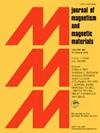磁场对强制对流系统中 Fe3O4 纳米流体热性能的影响
IF 2.5
3区 材料科学
Q3 MATERIALS SCIENCE, MULTIDISCIPLINARY
引用次数: 0
摘要
本研究通过实验研究了磁场强度、雷诺数和纳米粒子浓度对 Fe3O4-水纳米流体的非稳态传热特性的影响。纳米流体的制备方法是将纳米粒子分散在水中,浓度分别为 0%、0.08% v/v 和 0.16% v/v,并使用稳定剂保持分散。在磁场作用下,采用了一个包裹在铜线圈(螺线管)中的双管系统,以促进自来水和纳米流体之间的热交换。螺线管产生所需的磁场。实验设计和分析采用了田口方法。结果表明,雷诺数、磁场强度和纳米流体浓度都能提高热传导率,但它们的作用机制各不相同。方差分析显示,雷诺数的影响最大,但仅限于低雷诺数。而纳米粒子浓度和磁场强度的影响则不相上下。研究结果表明,即使磁场与流体流向一致,也可以作为一个辅助因素来增强铁流体中的热传递,尤其是当纳米粒子浓度的增加受到压降上升和团聚风险的限制时。本文章由计算机程序翻译,如有差异,请以英文原文为准。
Magnetic field effects on the thermal performance of Fe3O4 nanofluids in a forced convection system
This study experimentally investigates the effects of magnetic field strength, Reynolds number, and nanoparticle concentration on the unsteady heat transfer characteristics of a Fe3O4-water nanofluid. The nanofluid was prepared by dispersing nanoparticles in water at concentrations of 0 %, 0.08% v/v and 0.16% v/v, using a stabilizer to maintain dispersion. A double-pipe system, encased in a copper coil (solenoid), was employed to facilitate heat exchange between tap water and the nanofluid under magnetic field. The solenoid exerts the desired magnetic field. The Taguchi method was utilized for experimental design and analysis. Results indicate that the Reynolds number, magnetic field strength, and nanofluid concentration all enhance the heat transfer rate; however, their effects differ due to distinct mechanisms of action. Analysis of variance reveals that the Reynolds number has the most significant impact although at low Reynolds only. This is while the effects of nanoparticle concentration and magnetic field strength are comparable. The findings suggest that even a magnetic field aligned with the fluid flow can serve as an auxiliary factor to enhance heat transfer in ferrofluids, particularly when increasing nanoparticle concentration is constrained by rising pressure drops and the risk of agglomeration.
求助全文
通过发布文献求助,成功后即可免费获取论文全文。
去求助
来源期刊

Journal of Magnetism and Magnetic Materials
物理-材料科学:综合
CiteScore
5.30
自引率
11.10%
发文量
1149
审稿时长
59 days
期刊介绍:
The Journal of Magnetism and Magnetic Materials provides an important forum for the disclosure and discussion of original contributions covering the whole spectrum of topics, from basic magnetism to the technology and applications of magnetic materials. The journal encourages greater interaction between the basic and applied sub-disciplines of magnetism with comprehensive review articles, in addition to full-length contributions. In addition, other categories of contributions are welcome, including Critical Focused issues, Current Perspectives and Outreach to the General Public.
Main Categories:
Full-length articles:
Technically original research documents that report results of value to the communities that comprise the journal audience. The link between chemical, structural and microstructural properties on the one hand and magnetic properties on the other hand are encouraged.
In addition to general topics covering all areas of magnetism and magnetic materials, the full-length articles also include three sub-sections, focusing on Nanomagnetism, Spintronics and Applications.
The sub-section on Nanomagnetism contains articles on magnetic nanoparticles, nanowires, thin films, 2D materials and other nanoscale magnetic materials and their applications.
The sub-section on Spintronics contains articles on magnetoresistance, magnetoimpedance, magneto-optical phenomena, Micro-Electro-Mechanical Systems (MEMS), and other topics related to spin current control and magneto-transport phenomena. The sub-section on Applications display papers that focus on applications of magnetic materials. The applications need to show a connection to magnetism.
Review articles:
Review articles organize, clarify, and summarize existing major works in the areas covered by the Journal and provide comprehensive citations to the full spectrum of relevant literature.
 求助内容:
求助内容: 应助结果提醒方式:
应助结果提醒方式:


